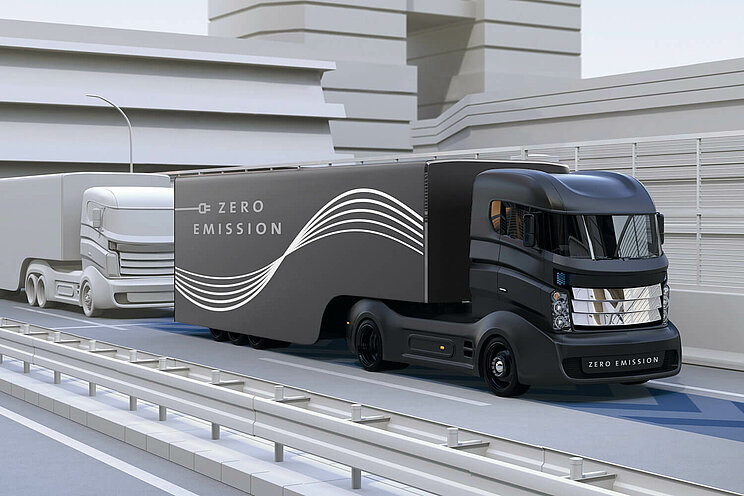
Charging infrastructure
The initiative hEVy Charge EU invited to a "Panel on European heavy-duty charging infrastructure" on 15 November 2022 at the Representation of the State of Baden-Württemberg to the European Union in Brussels. Germany and the Netherlands in particular have set up similar national strategies. There is great interest in a further exchange with the involvement of other national infrastructure agencies.
In addition to the total cost of ownership (TCO), a decisive point for the market ramp-up of climate-friendly drives is the necessary charging and refuelling infrastructure. "The transformation of commercial vehicle powertrains has begun. Now it is crucial that the European infrastructure keeps pace with the spread of corresponding vehicles," said e-mobil BW President Franz Loogen. The topics of vehicle availability and charging infrastructure deployment were discussed during the event together with representatives of ACEA, CharIN e.V., the European Commission and the National Centre for Charging Infrastructure, among others.
At this year's IAA Transportation in Hannover, numerous vehicle manufacturers already showed new electric long-haul trucks and indicated timely availability. Thomas Fabian, Director Commercial Vehicles of the ACEA, stressed: “Vehicles are in series production or about to be launched on the market and will not be the bottleneck for the transition to climate-neutral freight transport." Instead, he said, it is even more important to focus on measures to expand the charging infrastructure to stimulate demand for battery-electric heavy-duty vehicles and enable the transition to CO2 neutrality.
To ensure that the energy storage systems of battery-electric heavy-duty trucks can be charged in as short time as possible, fast-charging standards are of great importance, just as they are for passenger cars. Glenn Cezanne, CharIN e. V., emphasised: „Standardisation is at the heart of, and linked to all elements of the e-mobility sector. The roll-out and uptake of e-mobility is highly facilitated by the introduction of standards such as the Megawatt Charging System connector. And, it is a highly indicatory to see that even though the standardisation for MCS might still take until 2024, there are very strong signals from industry for an interest to implement the technology as soon as possible.”
The event also provided an opportunity for various national bodies responsible for the roll-out of charging infrastructure in their countries to present their own strategies and exchange views on possible overlaps between them. In this context, Jan Steffens, National Centre for Charging Infrastructure, gave an overview of the overall approach to climate-friendly commercial vehicles, which forms the framework plan for German activities in the field of charging infrastructure. The recently published Master Plan Charging Infrastructure II also provides a separate chapter for HDCV. The National Charging Infrastructure Control Centre collects and analyses data on various usage scenarios, publishes evaluations as well as general information on the construction and operation of public charging stations. The Dutch counterpart to the National Centre for Charging Infrastructure in Germany, the National Agenda Laadinfrastructuur, has prepared similar analyses of the current energy and charging infrastructure network and also offers tools to support industry and the public sector in the roll-out of charging infrastructure.
The event was able to clearly show that Germany and the Netherlands in particular have set up similar national strategies for the roll-out of charging infrastructure. There is therefore great interest in a further exchange with the involvement of other national infrastructure agencies.
It is crucial for the market uptake of battery-powered trucks in long-distance transport that charging is possible throughout Europe. Dario Dubolino, DG Transport and Mobility, therefore presented the measures and objectives planned by the European Commission on the topic of charging infrastructure. The European Sustainable and Smart Mobility Strategy aims to make the European transport system more sustainable, intelligent and resilient and to achieve a 90% reduction in emissions by 2050.
The objectives, especially in the AFIR, are an important approach from the car manufacturers' point of view, but do not yet go far enough. Despite the high relevance of the topic, no coordinated European approach to the development of charging infrastructure for battery-electric long-haul trucks is currently discernible. Local charging infrastructure initiatives are not interconnected and therefore contribute only to a limited extent to a comprehensive coverage of the European transport corridors. Therefore, the hEVy Charge EU initiative aims to contribute to a European strategy for the roll-out of charging infrastructure for battery-electric long-haul trucks.
The panel on "European heavy-duty charging-infrastructure" enabled a first meeting of the relevant stakeholders for the topic and provided the platform for a constructive discussion between all participants.

hEVy Charge EU is an initiative coordinated by seven regional mobility clusters to support the rapid market roll-out of battery electric heavy-duty trucks by contributing to the realisation of a coherent Europe-wide charging corridor.